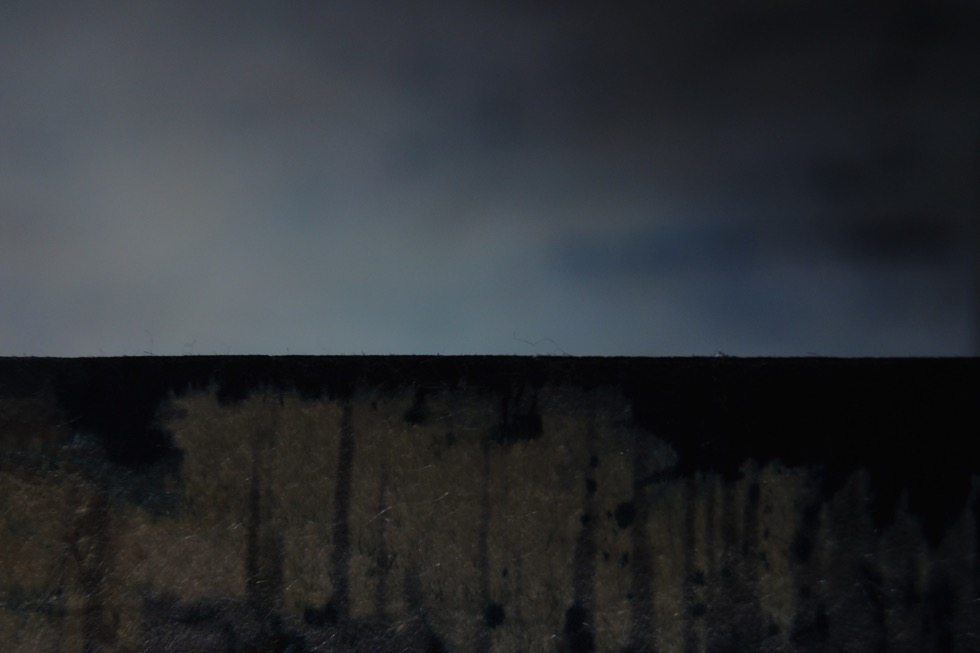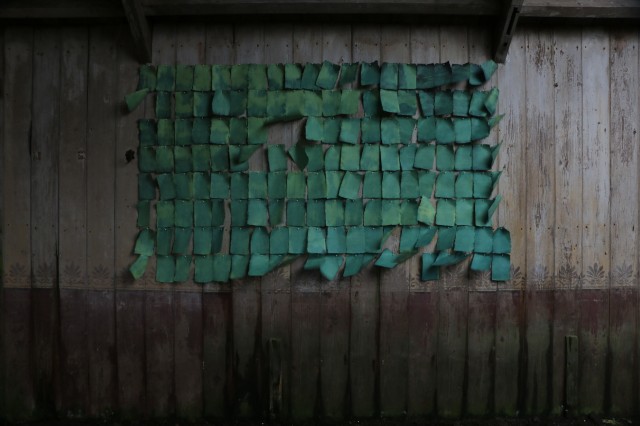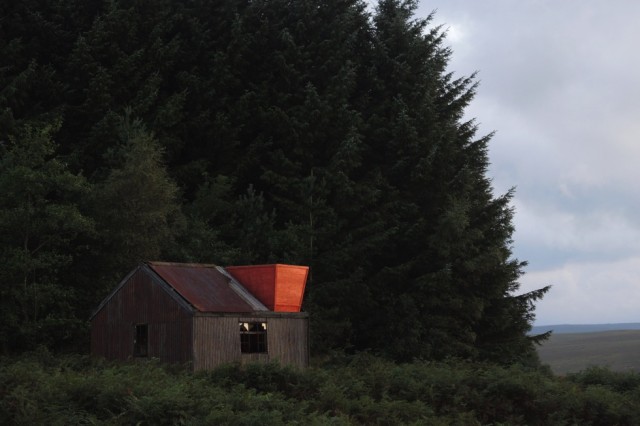“It takes an artist to interpret the spring light…” Lucy May Schofield’s Blue Hours

Artist Lucy May Schofield has been capturing the delicate blue light of the Northumberland landscape — from dawn to dusk and in all weathers — finds Nancy Campbell…
One of the most imaginative minds in science, Albert Einstein, believed that equations were waiting to appear to the person who looked hard enough, like secret finger-writing on a mirror, revealed when steam hits the surface. Finding them just required the right conditions — and insatiable curiosity. “You can act as if everything or nothing is a miracle”, he wrote. The remarkable work of Lucy May Schofield revels in a similar quiet belief in the miraculous nature of the everyday. As this year’s VARC (Visual Arts in Rural Communities) artist-in-residence, Schofield examines with wonder both minute details of the Northumberland landscape and its more intangible elements, such as how light and time inform our experience of location.
The length of time VARC provides for an artist-in-residence at Highgreen is generous, but even a year is finite. Schofield adopts this constraint as a robust structure for a series of works which narrate the seasons, days, hours. She charts her experience of this landscape through 12 months, from dawn to dusk and in all weathers. There’s an Icelandic saying, glöggt er gests angað, or “the visitor sees things with a clear eye.” By tuning her artistic practice respectfully to the established rhythm of the seasons, this clear-eyed newcomer is able to enter into dialogue with a time-honoured experience of the landscape. The surroundings of Highgreen may change down the generations, but patterns of growth and decay recur, planets and constellations return to the same point in the sky. Just so, the viewer will be able to recognise motifs and devices running through this body of work, such as the signature blue colour, or the variations on the perfect rectangle — whether a hand-made sheet of paper or a window frame.
Such attention to the temporal makes every day an event to be celebrated, but Schofield has created major works to mark the turning points of the four seasons. The Vernal Equinox, for example, saw Schofield’s sleep performance Awake, in which the artist slept outside from sunrise to sunset, her (occasionally shifting) body shielding the sheet on which she lay from the daylight. The light transformed the exposed areas of the sheet, turning the UV light-sensitive silk blue. A time-lapse film of the performance charts the colours of the moor, which change from sere to russet as the sun sinks below the horizon. Plane contrails appear and fade, but these are not the only travellers. Schofield’s film 5.55–18:33 brings to mind the vast distances the light journeys from the sun, the dizzying speed at which it moves towards us. Human timescales are slower, shorter. It takes an artist to interpret the spring light, to show its true colours.

During her residency Schofield reflected on the meaning of blue: “The depth of indigo, that dive-into-the-blueness blue, the blueness of loss, of wonder, of grief, of freedom, of desire, of lament. That bluest of blue.” Since ancient times, blue has spoken of distance and memory. In Leonardo da Vinci’s instructions to painters, he writes about how to create the illusion of remoteness: “the next most distant make less outlined and more blue; that which you wish to show at yet another distance, make bluer yet again; and that which is five times more distant make five times more blue.” Blue is the deepest water, the remembered hills; and from space we are reduced to blue, as in NASA’s iconic 1968 Earthrise photograph of our “blue planet” with its swirling surface.
Schofield’s use of cyanotype calls to mind the work of the botanist Anna Atkins, a Victorian pioneer of scientific illustration, who used the process to make exquisite studies of sea algae. Cyanotype is a traditional medium for recording observation of the natural world. But Schofield moves away from representative image-making; rather than laying botanical specimens on the light-sensitive paper to create a ghostly silhouette, her cyanotypes witness the action of light itself. In The Last Light 160 tiny sheets of paper, having been pinned to an inner wall of a derelict shooting hut, record the light at the Winter Solstice. The variety of blue tones on these sheets echo the blue of the sky — itself an illusion, the result of the selective scattering of sunlight by air molecules. This light from the sun, so essential to life on earth, is dearest to us on the shortest day. This haunting work is partnered by The Longest Day, created at the Summer Solstice, in which Schofield completely covered the hut’s south-facing exterior wall with sheets of paper on a scale befitting summer’s plenty. Over one thousand time-lapse images record the infinitesimal tonal shifts on the cyanotypes and in the skies above during the long hours of daylight.

Light, together with the physiology of sight, enables our visual experience of the world. Schofield describes her own way of looking as a “caress,” a term which encompasses the physicality of sight, the way the eye glances along an object and lingers on those aspects it finds most intriguing or beautiful. Schofield distils these “caresses” through mokuhanga printmaking, a form of mark-making in which the artist’s intentions are mediated through gestures with carving tools in wood. The woodblocks are printed using water-based pigments, and as the paper is peeled back the image is revealed in reverse, as in a mirror. Over time these discrete observations gathered on daily walks and worked on back in the studio have grown into a mesmerising collective record of Highgreen through the seasons.
We always experience the environment through a human filter, whether that’s our own eye, the camera lens, or another’s words. Weak from Dreaming, a site-specific installation for the Autumn Equinox, creates a home for the human viewpoint in this landscape. The derelict shooting hut becomes a place to shoot not game but images: an observatory of wonder. Schofield’s first photographs of the shooting hut show her fascination with the angularity of the building in contrast to the soft hills, and the way the rusted corrugated iron and splintered wood frames the enduring landscape. If Schofield, who has admitted at times to being daunted by the wide horizons, found security in this man-made structure, which has been re-made by the work of time and weather, she would also appreciate the irony inherent in its friable nature: the roof has fallen in, leaving the “shelter” exposed to the sky. Rather than feeling obliged to repair it, Schofield has turned her intrepid imagination to authenticate its broken-ness, leaving a point of exit/ entry for the elements. The structure is ambitious in scale and scope; it frames the sky, and invites others in to share the view or to stargaze.
In this, as in all the works collected in Blue Hours, Schofield listens, and lets nature speak. She might even be relaying the advice of that famous scientist. “Look deep into nature,” Einstein wrote, “and then you will understand everything better.”
Nancy Campbell
Nancy Campbell is a writer and book artist whose work explores northern environments. Disko Bay, a poetry collection written at Greenland’s most northern museum, was shortlisted for the Forward Prizes 2016 and the Michael Murphy Memorial Prize 2017. She writes on art for the Times Literary Supplement, Printmaking Today and the Royal Academy
Originally commissioned by VARC (Visual Arts in Rural Communities) to commemorate Lucy May Schofield’s 2017 residency and finale exhibition, Blue Hours: open by appointment until 21 Sept 2017, 10am–5pm at VARC, Highgreen, Northumberland — FREE
Image credits from top:
The Longest Day
Cyanotype on handmade mulberry paper for Summer Solstice 2017
Installation for Blue Hours
photo: K.Adibi
The Last Light (Blue Hour)
Cyanotype on handmade mulberry paper, Winter Solstice 2016
Installation for Blue Hours
photo: K.Adibi
Weak From Dreaming
Site specific installation for Autumn Equinox 2017
photo: K.Adibi





